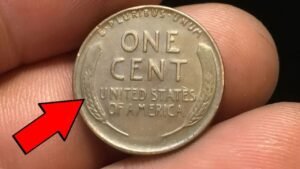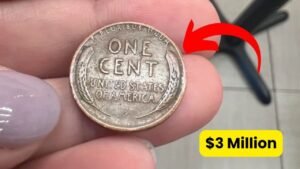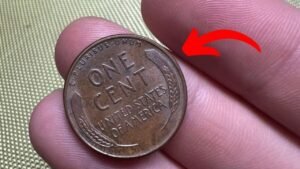you’re rummaging through your loose change, and among the shiny quarters and worn dimes, you spot a grimy old penny. It looks like nothing special, but what if that penny could buy you a fancy car or a down payment on a house? Welcome to the wild world of the Lincoln Wheat Penny, where a single cent could be worth $100,000 or more! Buckle up for a treasure hunt through history, mistakes, and jaw-dropping coin values.
The Allure of the Lincoln Wheat Penny
The Lincoln Wheat Penny isn’t just pocket change—it’s a tiny piece of American history that’s sparked a modern-day gold rush for coin collectors. Minted from 1909 to 1958, this humble coin was the first U.S. coin to feature a real person, President Abraham Lincoln, breaking away from the symbolic Lady Liberty designs of the past. Designed by Victor David Brenner, it sports Lincoln’s profile on the front and two wheat stalks on the back, earning its nickname “Wheat Penny.” But what makes certain versions of this coin worth more than a luxury vacation? Let’s dive into the magic of rarity, errors, and historical quirks that turn these pennies into treasures.
A Coin Born from a Milestone
In 1909, the U.S. Mint rolled out the Lincoln Wheat Penny to celebrate the 100th anniversary of Abraham Lincoln’s birth. This wasn’t just a design change; it was a bold move in American coinage. Before this, coins featured allegorical figures, but putting a president’s face on a penny was revolutionary. Brenner’s design captured Lincoln’s dignified profile on the obverse, while the reverse showcased two wheat stalks framing “One Cent,” symbolizing America’s agricultural roots. This iconic design stayed in circulation for nearly half a century, until the Lincoln Memorial replaced the wheat stalks in 1959.
The Drama of the VDB Controversy
One of the most famous Wheat Pennies, the 1909-S VDB, comes with a juicy backstory. Brenner proudly stamped his initials, “VDB,” on the reverse, but some folks thought it was too flashy for a coin. The public outcry led the Mint to yank the initials after only 484,000 coins were minted in San Francisco. This limited run turned the 1909-S VDB into a collector’s holy grail, with well-preserved examples fetching over $100,000 at auction. Talk about a tiny signature causing a big stir!
Wartime Blunders and Million-Dollar Mistakes
Fast forward to World War II, and we get to the crown jewel of Lincoln Wheat Pennies: the 1943 copper penny. During the war, copper was in high demand for military supplies, so the Mint switched to zinc-coated steel for pennies. But—oops!—a few copper blanks from 1942 slipped through the cracks and were stamped with the 1943 date. Only about 20 to 40 of these error coins are known to exist, making them insanely rare. One sold for $204,000 in 2019, and in top condition, they can fetch upwards of $1.7 million. Imagine finding one of those in your piggy bank!
Other Errors That Pay Big
The 1943 copper penny isn’t the only mistake that made collectors’ hearts race. The 1955 Doubled Die penny is another gem, where a misalignment in the minting process caused the date and lettering to appear doubled. Around 20,000 of these error coins hit circulation before the error was caught, and today, a pristine one can sell for over $125,000. Then there’s the 1922 No D penny, where the Denver Mint accidentally left off the “D” mint mark, creating another rare find that collectors covet.
How to Spot a $100K Penny
So, how do you know if that dusty penny in your coin jar is a jackpot? It’s all about checking a few key details. Here’s your treasure-hunting checklist:
- Date and Mint Mark: Look for rare years like 1909, 1914, 1922, 1943, or 1955. The mint mark, found below the date, is crucial— “S” (San Francisco) or “D” (Denver) coins are often rarer than those from Philadelphia (no mint mark).
- Material: For 1943 pennies, do the magnet test. Steel pennies stick to a magnet; copper ones don’t. A copper 1943 penny weighs about 3.11 grams, while steel ones are lighter at 2.7 grams.
- Condition: Coins in mint or uncirculated condition are worth more. Look for sharp details and minimal wear.
- Errors: Use a magnifying glass to spot doubled lettering, missing mint marks, or off-center designs.
If you think you’ve got a winner, don’t clean it! Cleaning can scratch the surface and tank its value. Instead, store it in a protective holder and take it to a professional numismatist for authentication.
Where to Find These Hidden Gems
The thrill of the Lincoln Wheat Penny hunt is that these coins could be anywhere. Here are some hot spots to check:
- Pocket Change: Yes, it’s a long shot, but valuable pennies have been found in circulation.
- Coin Rolls: Buy rolls of pennies from banks and search through them—a hobby called “coin roll hunting.”
- Old Collections: Check inherited coin jars, family heirlooms, or dusty attic boxes.
- Flea Markets and Estate Sales: Sellers might not know the value of their coins, giving you a chance to score a deal.
- Online Auctions: Sites like eBay or Heritage Auctions often have Wheat Pennies, but beware of scams—stick to verified sellers.
Pro Tips for Coin Hunters
Joining coin collector forums or clubs can give you insider tips and connect you with experts. Services like the Professional Coin Grading Service (PCGS) or Numismatic Guaranty Corporation (NGC) can grade and authenticate your coins, boosting their market value. And always keep an eye on numismatic news for market trends—coin values can fluctuate based on demand and new discoveries.
The Big Players: Most Valuable Lincoln Wheat Pennies
To make your treasure hunt easier, here’s a quick rundown of the most sought-after Lincoln Wheat Pennies and what makes them special:
| Penny Type | Year | Mint Mark | Why It’s Valuable | Estimated Value |
|---|---|---|---|---|
| 1909-S VDB | 1909 | S | Low mintage (484,000), designer’s initials | $1,000–$100,000+ |
| 1943 Copper Penny | 1943 | None, D, S | Rare error (copper instead of steel) | $100,000–$1.7M+ |
| 1955 Doubled Die | 1955 | None | Visible doubling on date and lettering | $1,000–$125,000+ |
| 1922 No D | 1922 | None | Missing Denver mint mark | $500–$10,000+ |
| 1914-D | 1914 | D | Low mintage, high demand | $200–$10,000+ |
Note: Values depend on condition and market trends. Always get a professional appraisal.
Preserving Your Potential Fortune
Found a penny that might be worth big bucks? Handle it with care to keep its value intact. Hold coins by the edges to avoid oil and dirt damage. Store them in acid-free holders or albums designed for coins. Never clean a coin—those shiny polishes can cause micro-scratches that collectors hate. If you’re serious about selling, get it graded by PCGS or NGC to confirm authenticity and condition, which can significantly boost its auction price.
The Myth-Busting Corner
There are plenty of myths floating around about Wheat Pennies. Let’s clear up a few:
- Myth: All Wheat Pennies are worth a fortune.
Reality: Most are worth just a few cents unless they’re rare dates, errors, or in pristine condition. - Myth: Cleaning makes coins more valuable.
Reality: Cleaning often reduces value by damaging the surface. - Myth: All 1943 pennies are copper.
Reality: Most are steel; copper ones are the rare exception.
Why the Lincoln Wheat Penny Still Captivates
Beyond the potential for striking it rich, the Lincoln Wheat Penny is a tangible link to America’s past. It debuted during a time of industrial growth, survived the Great Depression, and played a role in wartime sacrifices. Each coin tells a story—of a nation honoring its greatest president, of minting mistakes that became legends, and of collectors chasing dreams. Whether you’re a seasoned numismatist or just curious, checking your change for a Wheat Penny is like playing a lottery with history.
The Thrill of the Hunt
Coin collecting isn’t just about money; it’s about the chase. The idea that a $100,000 penny could be hiding in your couch cushions or a flea market box is what keeps collectors hooked. It’s a blend of history, detective work, and the hope of uncovering something extraordinary. Even if you don’t find a million-dollar penny, the stories behind these coins make every search worthwhile.
Conclusion: Your Next Penny Could Be a Game-Changer
The Lincoln Wheat Penny is proof that the smallest things can hold the biggest surprises. From the 1909-S VDB’s controversial debut to the 1943 copper penny’s wartime fluke, these coins are more than money—they’re pieces of history that could make you rich. So, next time you get change at the coffee shop or dig through an old jar, give those pennies a second look. With a little luck and a keen eye, you might just find a tiny treasure worth $100,000. Happy hunting!
FAQs About Lincoln Wheat Pennies
Q: How can I tell if my Lincoln Wheat Penny is valuable?
A: Check the date, mint mark, and condition. Look for rare years like 1909, 1914, 1922, 1943, or 1955, and errors like doubled dies or missing mint marks. Use a magnet for 1943 pennies—copper doesn’t stick. Get it appraised by a professional for accuracy.
Q: Where can I find rare Lincoln Wheat Pennies?
A: Search pocket change, bank coin rolls, old collections, flea markets, or online auctions like eBay or Heritage Auctions. Coin roll hunting and estate sales are popular among collectors.
Q: Should I clean my Wheat Penny to make it look better?
A: No! Cleaning can damage the coin’s surface and reduce its value. Handle it by the edges and store it in a protective holder.
Q: What’s the most valuable Lincoln Wheat Penny?
A: The 1943 copper penny is the rarest, with values up to $1.7 million in top condition. The 1909-S VDB and 1955 Doubled Die are also worth $100,000+ in pristine condition.
Q: How do I get my penny appraised?
A: Take it to a reputable numismatist or grading service like PCGS or NGC. They’ll verify authenticity and grade the coin’s condition, which affects its market value.
Q: Are all Lincoln Wheat Pennies rare?
A: No, most are common and worth a few cents. Only specific years, mint marks, or errors—like the 1943 copper or 1955 Doubled Die—are highly valuable.




